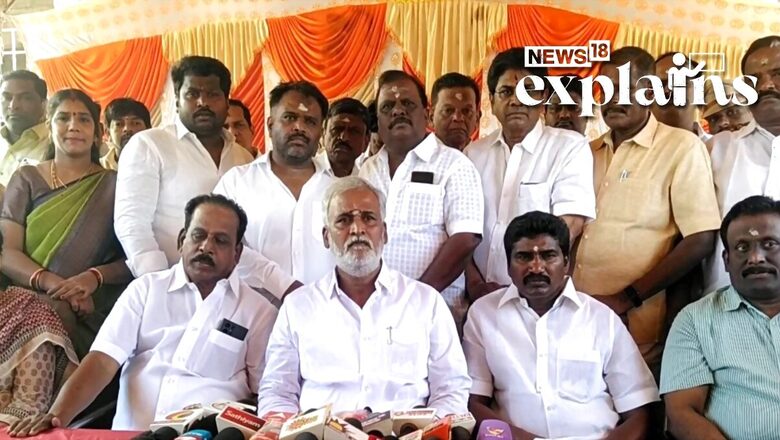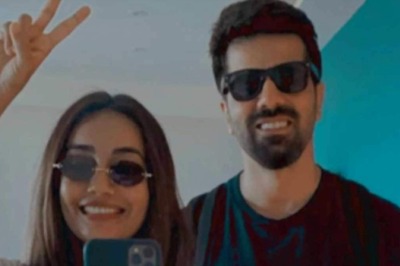
views
On Tuesday, the Chidambaram town police in Cuddalore district booked 11 podhu dikshitars, the hereditary priests and custodians of the Lord Nataraja Temple, on charges of obstructing officials from the Hindu religious and charitable endowment (HR&CE) department from performing their duties.
What Exactly Happened?
Since June 24, the dikshitars had denied permission for devotees to offer prayers from the holy stage in the temple. They displayed a board stating that devotees would not be allowed to offer prayers from the holy stage starting from the eighth day of the ongoing festival, Aani Thirumanjanam, until its conclusion on June 27, according to a report by The Times of India.
On Saturday, HR&CE officials attempted to remove the board but faced opposition from the dikshitars. HR&CE executive officer Saranya filed a complaint with the Chidambaram town police, resulting in the booking of the podhu dikshitars’ committee secretary, Sivarama Dikshitar, and 10 others under various sections of the Indian Penal Code (IPC) and the Tamil Nadu Prohibition of Harassment of Women Act.
Subsequently, on Tuesday, district officials held peace talks with the dikshitars to resolve the issue. However, the dikshitars maintained that devotees could only offer prayers from the holy stage starting from Wednesday, not on Tuesday, as the pooja had already commenced, as per the report. Nevertheless, the police managed to escort a few devotees into the temple on Tuesday night and allowed them to offer prayers from the holy stage.
In May of the previous year, the Tamil Nadu government passed an order permitting devotees to offer prayers from the holy stage at the Chidambaram Nataraja Temple. The dikshitars had prohibited devotees from doing so since the lockdown was imposed in March 2020 to prevent the spread of COVID-19 until the government intervened in May last year.
HR&CE Minister P K Sekar Babu, while briefing reporters in Chennai on Tuesday, stated that the government had initiated efforts to bring the Chidambaram Nataraja Temple under the administrative control of HR&CE. He also mentioned that the priests desired the temple to be declared as a denomination temple exclusively earmarked for a particular sect or community.
Will Bring Temple Under Govt: Minister
Accusing the Podu Dikshitars managing the famous Nataraja temple in Tamil Nadu’s Chidambaram of not divulging information to the government on temple funds or assets, Hindu Religious and Charitable Endowments Minister P K Sekar Babu on Tuesday said efforts are on to bring this shrine under the ambit of his department.
“We are on the side of justice and devotees. We will gradually overcome all hurdles and will take over the administrative control of the temple with the sanction of the court,” Sekar Babu told reporters here when his attention was drawn to the removal of the board.
For about a year, the state government and the HR&CE department have been attempting to gain control of the temple in Cuddalore district that is being managed by the hereditary priests. “We have responded to it legally,” said Podu Dikshitars committee secretary T S Sivarama Dikshitar. His lawyer G Chandrasekhar said the board has been placed to inform devotees coming from outstation and to avoid crowding during the festival.
Contending that a group of 200 priests decided on how to manage the temple and thereby became a law unto themselves, the Minister said on earlier occasions the priests declined to provide information to the government on funds available with the temple or disclose the stock on gold ornaments at the shrine.
“These Dikshithars are functioning from a power centre they have created. Unlike other temples being managed by the HR&CE, this temple does not have any hundial or a stock register. The temple accounts have not been audited,” the Minister said.
The 2014 Ruling
In 2014, the Supreme Court has declared that the Nataraja Temple in Chidambaram will be managed by the priests and not the state government. The court deemed the Tamil Nadu government’s order from July 1987, appointing an executive officer to oversee the temple, as “arbitrary, illegal, and unjust.” The government had intervened citing alleged malpractices by the priests, according to a report by Telegraph.
About the Nataraja Temple
The Chidambaram shrine, also known as the Thillai Natarajar Temple, is believed to have been constructed during the 12th-13th century. The name “Thillai” refers to a type of mangrove tree found in the nearby swamps. “Chidambaram,” signifies “he who has the sky draped around him like a cloth,” combining “Chid” (sky) and “Ambaram” (cloth). The Lord in this temple is associated with the five natural elements, with the sky being the focus in Chidambaram.
It is said to be the only temple where Shiva manifests in three forms: as Nataraja, the cosmic dancer, in human form; as a Spatika Linga (a crystal phallus worshipped six times daily); and as an invisible space within the sanctum sanctorum, giving rise to the Tamil expression “Chidambara Rahasyam” (the secret of Chidambaram). According to legend, the Spatika Linga was presented by Adi Shankara.
For a long time, the temple was administered by the Podu Dikshitars, an endogamous clan exclusive to Chidambaram, in accordance with a temple constitution drafted centuries ago and first printed in 1849.
However, a government order had previously stripped the administration of the temple from the hands of the Podu Dikshitars. The 2014 Supreme Court ruling had restored the administration back to them. The court recognized the Dikshitars as a “religious denomination” and emphasized the need to preserve and protect their rights from state intervention.
Who are Podu Dikshitars?
The Podu Dikshitars are male members of the families of Smarthi Brahmins who believe they were called to establish the temple in the name of Lord Nataraja. Only after marriage does a Dikshitar gain the right to perform sacramental services and participate in the temple administration.
The Chidambaram Dikshitars differ from other Brahmins in various aspects. Their entire lives, religion, education, training, culture, and livelihood revolve around the Nataraja temple. They are dedicated to serving Nataraja and the Chidambaram temple from birth.
The Supreme Court had in 2014 clarified that while the government has the authority to take over the management of a temple to address instances of “maladministration,” such intervention cannot be indefinite. Once the issues are resolved, the management must be returned to the concerned individuals. Prolonged government control would infringe upon their proprietary rights and violate the fundamental rights guaranteed by the Constitution, the SC had said, according to the report.
Temple’s History
The temple has a rich history, having received devotion and generous grants from important dynasties such as the Pallavas, Pandyas, Cholas, Cheras, Vijayanagar, and the Marathas. Parantaka Chola had even adorned the sanctum with a golden roof.
Legend has it that Rajendra Chola I gifted the entire village to the Dikshitars, who took on the responsibility of temple rituals, management, as well as judicial and administrative duties of the village.
The Dikshitars are known for their unwavering commitment to defending the rights and sanctity of the Nataraja temple. In the 19th century, when a group attempted to enter the premises, the Dikshitars reportedly climbed the temple tower and threatened to leap to their deaths. Faced with this courageous response, the intruders hastily retreated.
During the colonial era, the East India Company and later the British Crown assumed control of numerous temples in South India through a regulation act. However, the Chidambaram temple managed to obtain an exemption from the Hindu Religious Endowment Bill of 1891. In 1925, the Podu Dikshitars successfully applied to the Governor-in-Council for exemption from related legislation.
PTI contributed to this report
















Comments
0 comment